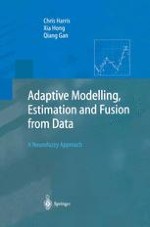2002 | OriginalPaper | Chapter
Learning laws for linear-in-the-parameters networks
Authors : Chris Harris, Xia Hong, Qiang Gan
Published in: Adaptive Modelling, Estimation and Fusion from Data
Publisher: Springer Berlin Heidelberg
Included in: Professional Book Archive
Activate our intelligent search to find suitable subject content or patents.
Select sections of text to find matching patents with Artificial Intelligence. powered by
Select sections of text to find additional relevant content using AI-assisted search. powered by
Despite the fact that artificial neural networks (ANNs) have been proposed primarily as nonlinear learning systems, considerable insight into the behaviour of these networks can be gained from linear modelling techniques, for which the literature is vast (see for example [8, 137, 181]), and significantly the resultant theory is directly applicable to a powerful and special class of ANNs, i.e. linear-in-the-parameters networks, which forms the basis of this book. An obvious reason to use ANNs is their ability to approximate arbitrarily well any continuous nonlinear function, with the specific network architecture and parameter/weight adjustment algorithm determining how well learning is achieved. Of particular interest in adaptive control and estimation is the ability of algorithms to model, track and control on-line. However, it is infeasible to assume that the input signals excite the whole of the state space (a prerequisite of identification theory), and so it is necessary to consider the effects of a reduced input signal on overall functional approximation for various network architectures and associated learning laws. Here learning must be local, in that adjustable network weights or parameters should only affect the network’s output locally. In ANNs, the vast majority of supervised learning rules are based on the assumption that the nonlinear network can be locally linearised, so that it is natural to develop on-line learning algorithms with provable learning network stability and convergence conditions, and to choose ANNs which have linear-in-the-parameters with local behavioural characteristics.
